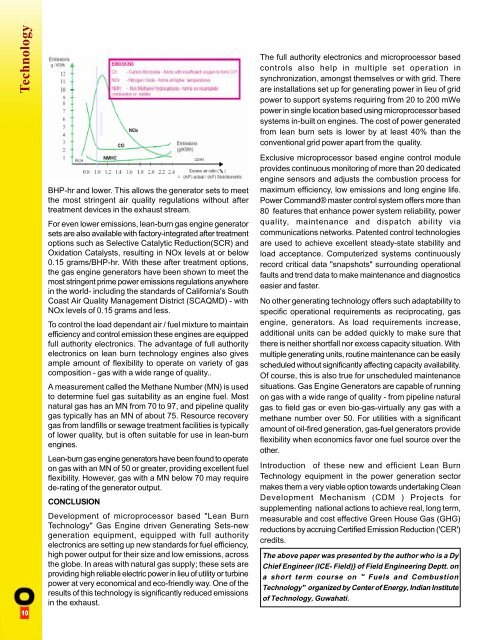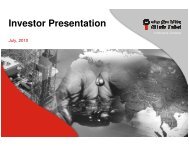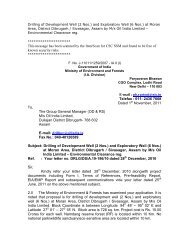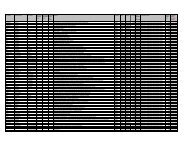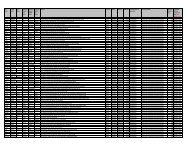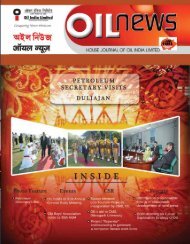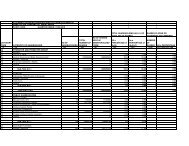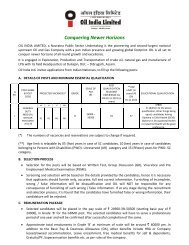Vol. 35 No. 8. May - Jun 2006 - Oil India Limited
Vol. 35 No. 8. May - Jun 2006 - Oil India Limited
Vol. 35 No. 8. May - Jun 2006 - Oil India Limited
You also want an ePaper? Increase the reach of your titles
YUMPU automatically turns print PDFs into web optimized ePapers that Google loves.
Technology<br />
The full authority electronics and microprocessor based<br />
controls also help in multiple set operation in<br />
synchronization, amongst themselves or with grid. There<br />
are installations set up for generating power in lieu of grid<br />
power to support systems requiring from 20 to 200 mWe<br />
power in single location based using microprocessor based<br />
systems in-built on engines. The cost of power generated<br />
from lean burn sets is lower by at least 40% than the<br />
conventional grid power apart from the quality.<br />
10<br />
BHP-hr and lower. This allows the generator sets to meet<br />
the most stringent air quality regulations without after<br />
treatment devices in the exhaust stream.<br />
For even lower emissions, lean-burn gas engine generator<br />
sets are also available with factory-integrated after treatment<br />
options such as Selective Catalytic Reduction(SCR) and<br />
Oxidation Catalysts, resulting in NOx levels at or below<br />
0.15 grams/BHP-hr. With these after treatment options,<br />
the gas engine generators have been shown to meet the<br />
most stringent prime power emissions regulations anywhere<br />
in the world- including the standards of California's South<br />
Coast Air Quality Management District (SCAQMD) - with<br />
NOx levels of 0.15 grams and less.<br />
To control the load dependant air / fuel mixture to maintain<br />
efficiency and control emission these engines are equipped<br />
full authority electronics. The advantage of full authority<br />
electronics on lean burn technology engines also gives<br />
ample amount of flexibility to operate on variety of gas<br />
composition - gas with a wide range of quality..<br />
A measurement called the Methane Number (MN) is used<br />
to determine fuel gas suitability as an engine fuel. Most<br />
natural gas has an MN from 70 to 97, and pipeline quality<br />
gas typically has an MN of about 75. Resource recovery<br />
gas from landfills or sewage treatment facilities is typically<br />
of lower quality, but is often suitable for use in lean-burn<br />
engines.<br />
Lean-burn gas engine generators have been found to operate<br />
on gas with an MN of 50 or greater, providing excellent fuel<br />
flexibility. However, gas with a MN below 70 may require<br />
de-rating of the generator output.<br />
CONCLUSION<br />
Development of microprocessor based "Lean Burn<br />
Technology" Gas Engine driven Generating Sets-new<br />
generation equipment, equipped with full authority<br />
electronics are setting up new standards for fuel efficiency,<br />
high power output for their size and low emissions, across<br />
the globe. In areas with natural gas supply; these sets are<br />
providing high reliable electric power in lieu of utility or turbine<br />
power at very economical and eco-friendly way. One of the<br />
results of this technology is significantly reduced emissions<br />
in the exhaust.<br />
Exclusive microprocessor based engine control module<br />
provides continuous monitoring of more than 20 dedicated<br />
engine sensors and adjusts the combustion process for<br />
maximum efficiency, low emissions and long engine life.<br />
Power Command® master control system offers more than<br />
80 features that enhance power system reliability, power<br />
quality, maintenance and dispatch ability via<br />
communications networks. Patented control technologies<br />
are used to achieve excellent steady-state stability and<br />
load acceptance. Computerized systems continuously<br />
record critical data "snapshots" surrounding operational<br />
faults and trend data to make maintenance and diagnostics<br />
easier and faster.<br />
<strong>No</strong> other generating technology offers such adaptability to<br />
specific operational requirements as reciprocating, gas<br />
engine, generators. As load requirements increase,<br />
additional units can be added quickly to make sure that<br />
there is neither shortfall nor excess capacity situation. With<br />
multiple generating units, routine maintenance can be easily<br />
scheduled without significantly affecting capacity availability.<br />
Of course, this is also true for unscheduled maintenance<br />
situations. Gas Engine Generators are capable of running<br />
on gas with a wide range of quality - from pipeline natural<br />
gas to field gas or even bio-gas-virtually any gas with a<br />
methane number over 50. For utilities with a significant<br />
amount of oil-fired generation, gas-fuel generators provide<br />
flexibility when economics favor one fuel source over the<br />
other.<br />
Introduction of these new and efficient Lean Burn<br />
Technology equipment in the power generation sector<br />
makes them a very viable option towards undertaking Clean<br />
Development Mechanism (CDM ) Projects for<br />
supplementing national actions to achieve real, long term,<br />
measurable and cost effective Green House Gas (GHG)<br />
reductions by accruing Certified Emission Reduction ('CER')<br />
credits.<br />
The above paper was presented by the author who is a Dy<br />
Chief Engineer (ICE- Field)} of Field Engineering Deptt. on<br />
a short term course on " Fuels and Combustion<br />
Technology" organized by Center of Energy, <strong>India</strong>n Institute<br />
of Technology, Guwahati.


